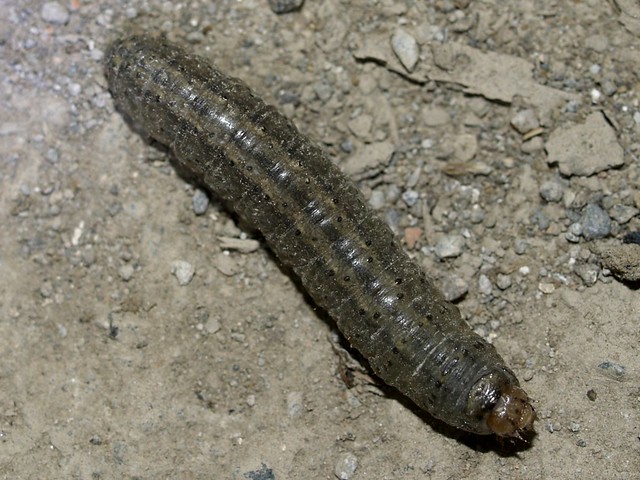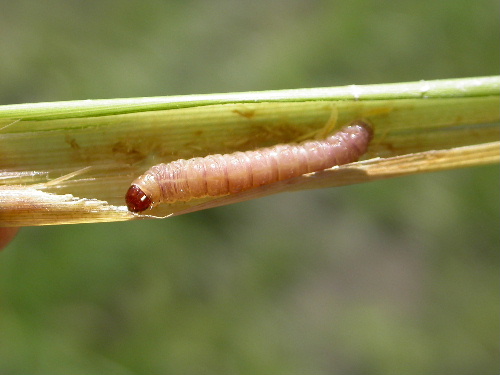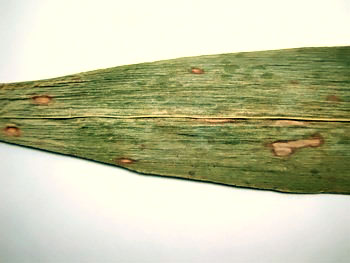Corn plant consists of roots, stems, leaves, flowers and seeds. Several types of pests and diseases that often damage maize plants and disrupt the growth of corn and affect productivity include:
Prior to the occurrence of pests and diseases in the corn crop, it can be implemented preventive measures by way of:
a. The use of resistant seed varieties
b. The use of agronomic techniques
c. The use of disinfectants to seeds to be planted
d. Maintenance and utilization of natural enemies
The final step to eradicate plant pests with the use of pesticide materials if the attack had reached the economic threshold or above the economic threshold, in this case must be carried out field research and data collection as well as possible.
1.Lundi pests
This pest attacking plants at the time of growth control by regulating the time of planting, or by using a systemic insecticide, which is sown into the ground, for example Mephosfolan or Carbofuran at a dose of 1.5 kg active ingredient / ha, another way of control is to plant more early. 2. Flies Seeds (Antherigona exigua Stein)
2. Flies Seeds (Antherigona exigua Stein)
This pest attacking the new seeds to grow, control is performed 2-3 days, or the use of insecticides folidol, agrocide, such as the recommended dose (eg 1.5 to 2 cc / liter of water)
3. Land caterpillar (Agrotis sp)
The pest are attack small plants, is controlled by manually by killing caterpillars, or sprinkled Carbopuran soil before planting. The following chemicals are recommended for spraying: carbaryl 0.2 per cent; endosulfan 0.04 per cent, dimethoate 0.03 per cent; quinalphos 0.05 per cent; formothion 0.05 per cent; methyl demeton 0.04 per cent, phosphamidon 0.02 per cent, methyl parathion 0.05 per cent and chlorpyrifos 0.05 per cent. 4. Leaf caterpillar (Prodenia litura F)
4. Leaf caterpillar (Prodenia litura F)
This pest attacking shoots at 1-month-old plants, should be sprayed with one of the recommended insecticides.The pests being nocturnal in their habits, control operations have to be taken up either during early morning hours or late evening hours or preferably during nights. Spraying or dusting with a persistent insecticide like carbaryl/ endosulfan/quinalphos at 0.1% gives satisfactory results to control the pest.
 5. Stem borer (Sesamia inferens Wlk)
5. Stem borer (Sesamia inferens Wlk)
This pest attacking plants that are flowering, prevention can be done by spraying the plants before flowering time (with a recommended insecticide and appropriate dosage). Spraying or dusting with a persistent insecticide like carbaryl/ endosulfan/quinalphos at 0.1% gives satisfactory results to control the pest. 6. Army worm (Leucania unifenuta HAW)
6. Army worm (Leucania unifenuta HAW)
This pest attacking plants grown in the evening, soon controlled when the attack has reached above the economic threshold. When once the larva mines into the leaf it will be in comparative safety against chemicals, particularly the dust forms. Hence the most rational approach is to treat the crop with penetrating sprays of contact insecticides timing the same either with the light trap information or with the first appearance of a few mines and larval chambers on the plants. Hence vigilance on the part of the farmer goes a long way in the control of this pest. The following chemicals are recommended for spraying: carbaryl 0.2 per cent; endosulfan 0.04 per cent, dimethoate 0.03 per cent; quinalphos 0.05 per cent; formothion 0.05 per cent; methyl demeton 0.04 per cent, phosphamidon 0.02 per cent, methyl parathion 0.05 per cent and chlorpyrifos 0.05 per cent.
 7. Cob worm (Heliothis armigera HSN)
7. Cob worm (Heliothis armigera HSN)
This is a plant destroyer of flies, will attack the fruit or corn, spray only when needed, spray a good time is between 6:00 to 9:00 a.m. the morning or in the evening between 16:00 to 18:00.Since the caterpillars in their early instars are gregarious in their feeding habit, collecting the leaves on which they are feeding along with egg mass collection and destroying them is necessary. Dusting with carbaryl or parathion or endosulfan @ 25-30 kg/ha a week after large scale emergence of moths controls the early instars of the caterpillars. However, control of grown up larvae is difficult due to thick growth of hair on their bodies. Spraying with DDVP, fenitrothion, endosulfan, dimethoate or formothion @ 0.1 per cent may control the grown up larvae to a satisfactory extent.
8. Corn Downy mildew
The diseases in the form of fungi (mushrooms), symptoms arise attack a wide yellow stripe on the leaves, when washed from the seed then any newly emerging young leaves appear yellow, is transmitted through seed or through wind-borne spores. Way control planting resistant varieties, planting simultaneously, mixing sentrimone. 9. Helminthosporium diseases
9. Helminthosporium diseases
This is fungal diseases with symptoms of an attack form a yellow oval spot at the center and surrounded by a brown color, attacking the leaves, stem and cob, how to avoid the control of continuous cultivation, spraying with a fungicide as per the instructions and recommendations.
In order to maintain the quantity and quality of production of maize farming, the practices to control pests and diseases is important to be implemented. The steps that need to be taken in plant pest control activities should take account of environmental rules and put the principles of integrated pest and disease control.
Tidak ada komentar:
Posting Komentar